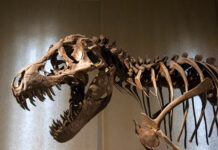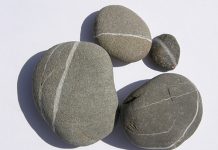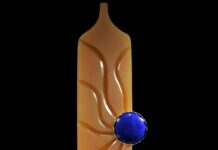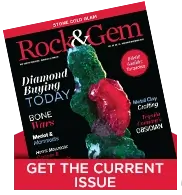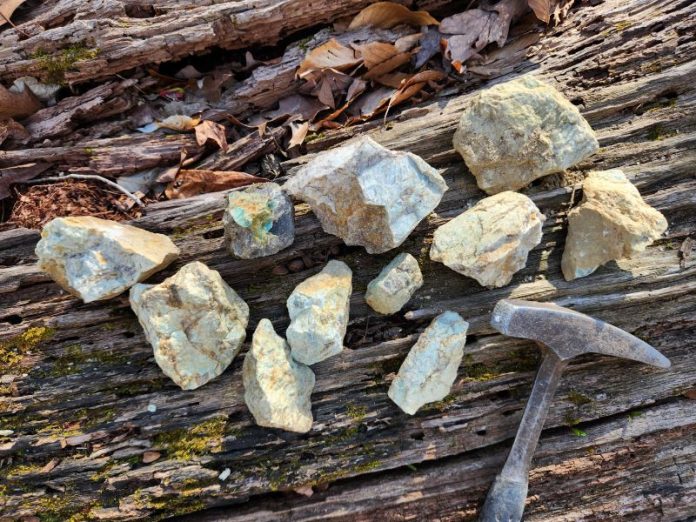
Amazonite, a light green potassium feldspar, can be found at Mineral Hill, located in southeast Pennsylvania, which is an area in the Delaware County Park system.
Mineral Hill has long been known for “exotic minerals.” It was private land and inaccessible until it was purchased by Delaware County in 2010. There are no posted restrictions against mineral collecting, but Delaware County Park regulations say that removal of rocks, as well as other natural features, is prohibited.
Not a formally named topographic feature, it is sometimes referred to as “Mineral Hill Park.” It is northwest of the intersection of Ridley Creek and East Baltimore Pike and just west of Media with a large parking area on the north side of the Pike.
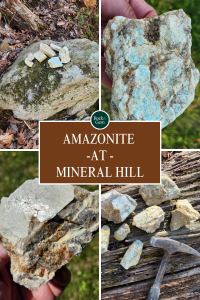
Geology of Mineral Hill
Mineral Hill is within the Media, PA, USGS 7.5-minute topographic quadrangle. The bedrock of the eastern section is Precambrian-age Wissahickon Formation, which is an oligoclase-mica schist and the western side is Precambrian-age serpentinite.
The Piedmont Geologic province of Pennsylvania consists of metamorphic and sedimentary rocks that have many of the most productive mineral-collecting sites in the state, but fossils are practically absent, except for some minor exceptions in Triassic rocks. The Piedmont can be further divided into the Piedmont Uplands, the Piedmont Lowlands, and the Gettysburg-Newark Lowland, which is also often referred to as the Triassic Basin. Mineral Hill is in the Piedmont Uplands section of the Triassic Basin of the province, which consists mainly of schist and gneiss and are among the oldest rocks in Pennsylvania.
The region has many large active aggregate quarries which are all private. Small iron mines ran in the area during the 1700s and 1800s but are long gone. Mineral Hill is one of the last remaining tracts of publicly accessible land with minerals that has not been developed.
Amazonite, which is one of the “exotic minerals” found at Mineral Hill, is a variety of green microcline. At Mineral Hill, the feldspar is generally light gray to tan to light green. Other minerals found at Mineral Hill include actinolite, chlorite, serpentine minerals, goethite and quartz.
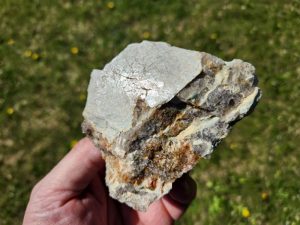
History of Mineral Hill
Development in Delaware County has been intense, and many of the former farms and mills were swallowed up by commercial and residential real estate developers long ago. Fortunately, many areas have been preserved through the creation of state and township parks and purchases by various preservation groups.
The Mineral Hill area consists of three contiguous parks, which are Memorial Park, established in 1998; Louis Scott Park, established in the 1990s and expanded in 2004; and Mineral Hill Park, purchased in 2010. The Mineral Hill Area Parks System totals 123 acres of contiguous public open space. The parks include forests, wetlands, floodplains and the main section of Ridley Creek. Aqua Pennsylvania used to own some of the parklands and was a key player in providing land for the parks.
The area is an important open space for Delaware County. The Boy Scouts had a camp at Mineral Hill, and the graffiti-covered ruins of their buildings are still on the site. They are a useful landmark for getting oriented at the site, as they are near some of the key trails that cross the park.
Memorial Park Parking
The Memorial Park parking area is the best way to access the site. A plaque at the parking area, titled “The Media Waterworks,” describes the early site history. The area was originally a hunting and fishing ground and trading path for the Lenni-Lenape and Okehocking Indian Tribes. In 1701, a gristmill and millhouse were built on Ridley Creek, and a dam was built on the creek. The property was bought by Media Borough in 1871 to build a waterworks, which was rebuilt and expanded in 1938 and 1955. Another plaque near a deck on Ridley Creek notes that this was the Fussell Recreation Skating area, named after Lewis Fussell, who was an accomplished ice skater. The winter temperatures are no longer low enough to freeze Ridley Creek for ice skating.
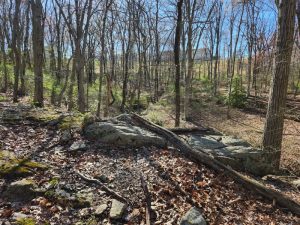
Visiting Mineral Hill
With the descriptions of exotic minerals at Mineral Hill, one might expect to find minerals that are easy to find and in great abundance. Unfortunately, it is not clear where mining has occurred unless you go to exactly the right spot.
My first trip to Mineral Hill was a bust. Despite climbing up the drainages and bushwacking through thorny briars, I only found some gneissic pegmatite outcrops near the Boy Scout camp ruins. These outcrops have white-to-tan feldspar and quartz. I found some loose light green amazonite in the soils around the outcrops. Mindat, in an entry on the Feldspar Quarry at Mineral Hill, has a picture of a shallow pit, but I did not find any pits or other features that matched this photograph on Mindat.
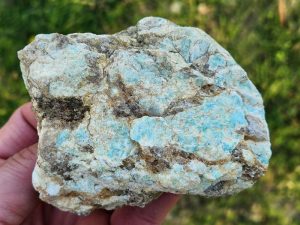
What is Amazonite?
The easiest way to describe amazonite, also known as amazonstone, is to say it is green microcline feldspar. Microcline is a potassium-rich feldspar and has the chemical formula KAlSi3O8. It has a small amount of sodium, which distinguishes it from orthoclase, which is also KAlSi3O8 but does not have trace sodium.
Feldspars are the most common minerals on Earth and form the bulk of all crystalline rocks as well as many sedimentary rocks derived from crystalline bedrock. Feldspar is from Swedish for field (feldt or falt) and spar (spat), since it is found in plowed fields on top of granitic bedrock.
Forming Feldspars
Feldspars form in a solid solution series where the amounts of potassium (K), sodium (Na), and calcium (Ca) form different feldspars. Granites and rhyolites are richer in potassium and sodium feldspars, while diabases and basalts are richer in calcium feldspars. Potassium-rich feldspars are often orange, sodium-rich feldspars are often white to light gray, and calcium-rich feldspars are often light to dark gray. Orange granites are rich in potassium feldspar, gray granodiorites have abundant sodium and calcium feldspars, and dark gray diorites are mostly calcium feldspars. To keep it simple, many geologists refer to the potassium feldspars microcline, orthoclase, and sanidine as K-spar, and the sodium- calcium feldspars albite, oligoclase, andesine, labradorite, bytownite and anorthite as plagioclase.
Feldspar, especially larger pieces, often exhibits good cleavage. K-spars can be distinguished from plagioclase as plagioclase has striations, which are narrow parallel groves that are present on one of the two cleavage planes in plagioclase. Microcline is in the triclinic crystal system, while the other alkali feldspars, orthoclase and sanidine, are in the monoclinic crystal system. Calcium-rich plagioclase feldspars are also monoclinic. Microcline got its name from the Greek for “little” and “slanted”, which refers to the slight variation in cleavage angle from 90 degrees.
Microcline
Microcline is often found in late-stage granites or pegmatites, and crystals of microcline are generally larger than crystals of orthoclase. Microcline can be clear, white, pale yellow, brick-red, or green. Large green potassium feldspar crystals are almost certainly microcline, as green orthoclase is extremely rare. If the feldspar is green, it then is generally referred to as amazonite and not as microcline. The green is due to trace amounts of lead in the feldspar crystal structure.
Amazonite is rare when compared to the abundance of other feldspars. The name reportedly comes from the Amazon River, but the river does not have any notable deposits. Notable international localities for amazonite are in Brazil, Australia, China, Libya, Mongolia, Sweden, and South Africa. In the United States, amazonite is found in Virginia, Wyoming, Pennsylvania and at several localities in Colorado.
Finding Amazonite
The following week, I spoke to a friend at a Harrisburg Area Geological Society meeting, and I described my frustration with Mineral Hill. He had recently been to the pit and sent me a map with specific directions to the site. I returned the following weekend to find the site.
My friend recommended approaching the area from the west, not from the southeast. I parked next to an empty soccer field and walked down the road to a trail, which was easy to find. I was told to continue on the trail and take it along the northern boundary of the park and stay south of the large apartments to the north. The trail soon became indistinct and was thick with thorny briars, and these were extremely painful to walk through, even with thick gloves and long pants. I was visiting the site in late April and thought that it would be much worse later in the summer.
I could not find a trail that went directly to the site, and I had to cross a small steep gully that drained eastward to reach the area of the pit. The gully, although not very wide, was nearly full of briars as well. My legs and arms were shredded by thorns. I soon came upon the pit, which was a shallow depression on the south side of the steep gully.
At the Amazonite Site – The Pit
The first thing that I noticed, in addition to the feldspar in the pit, was the ticks crawling up my legs. After removing them, I was able to check the pit. The pit had many broken rocks on the surface, and some of these were light green amazonite. Light gray to tan feldspar and smoky quartz were also present. Several rockhounds had been at the pit long before me, as small holes were dug in the pit and on the side next to the gully. The feldspar is primarily microcline, which is potassium feldspar (KAlSi3O8). It was generally light gray to tan and laced with dark gray smoky quartz and light green amazonite, which is green microcline. Some small pieces had a deeper green, but generally, the amazonite was very light green. Most of the pieces were broken and the loose rocks were fist-sized. The amazonite is within the matrix of the rocks and does not occur as distinct crystals. The amazonite has good cleavage, and the cleavage planes are reflective in the sunlight. Some pieces also have fine lamellae and a perthitic texture, which shows that some sodium feldspar is present with the potassium feldspar.
I looked around for other pits and outcrops, but this pit and the gneissic outcrops by the former Boy Scout camp were the main areas with amazonite. I found some chlorite and actinolite in the drainage just south of the trail on the west side of the area, but these were not in abundance. I did not see any other obvious “exotic minerals” so I assume the main exotic mineral is the amazonite, which by itself still makes this a worthwhile site to visit.
Revisiting Mineral Hill – A Different Approach
I revisited Mineral Hill in mid-April 2024. This time, I approached the area from the parking lot along East Baltimore Pike. I was able to find the Boy Scout ruins easily, but the pit was surprisingly hard to find again. There are still no distinct trails that lead to it, and I got sliced to ribbons by briars again. I eventually made it back to the pit and found there were more holes made by rockhounds. Stacks of microcline made by visitors were also in the small gully to the north. Mineral Hill is often visited by rockhounds, but fortunately people have generally respected the area, and it was relatively free of trash or other indications of inconsiderate visitors.
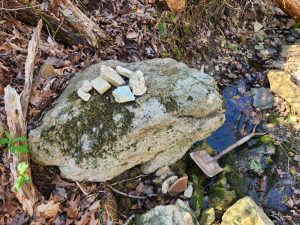
Getting to Mineral Hill
There are two main ways to access the former feldspar pit at Mineral Hill. It is highly recommended that you use a GPS and the coordinates provided in this article, as the pit is hidden by brush and can be hard to see. I recommend parking at the parking area for the Millennium Trail and hiking up the trail to the site. The trail roughly parallels the west side of Ridley Creek for about a quarter mile, and then you need to take one of the faint trails that lead up the slope. You will soon see the ruins of the former Boy Scout Camp. From the buildings, continue to follow the faint paths northward.
A large area of apartments is in development to the north, and these buildings are a useful guide. The best feature for finding the pit is a concrete storm drain on the side of the hill. The drain is easy to see and the pipe drain points in the direction of the pit.
The second way to reach the pit is to park on the west side of Mineral Hill on Valerie Way. This was the way my friend recommended, but I thought the brush was too thick. You can park next to the soccer field and head south to a trail in the woods that leads east. From here you can follow an indistinct trail through the briars to get to the pit.
GPS Coordinates to Find Amazonite
- Parking area next to East Baltimore Pike: 39°55’02.5”N 75°24’18.8”W
- Parking area on Valerie Way: 39°55’01.8”N 75°24’56.0”W
- Pit with amazonite: 39°55’12.6”N 75°24’43.2”W
While it can be hard to find and access, it is a relatively short and easy trip. You and your companions will enjoy the scenery and the open space that Mineral Hill provides. It is one of the few publicly accessible areas in Pennsylvania where you can easily see amazonite. While Delaware County Park regulations prohibit collecting rocks in the park, there are no restrictions on hiking to the site.




